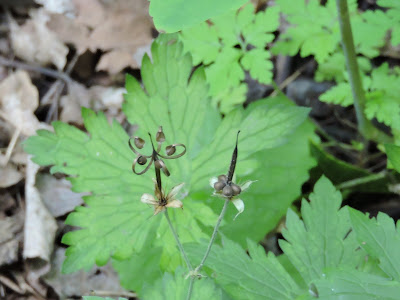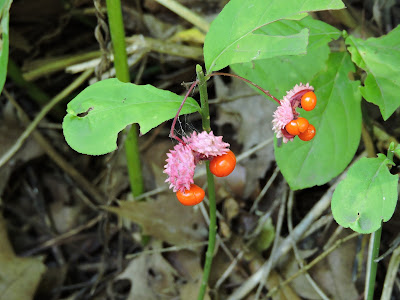The wild geranium has an ingenious method of spreading its seeds throughout the forest. The fruiting structure (on the right), that slender column, has five sections. The little cups at the base, each contain one seed and at maturity, they split apart and the seed is flung from the cup, leaving the fascinating star-shape on the left. Effective and elegant and not unlike a medieval trebuchet.
Virgin's Bower is part of the clematis family, but because the flowers, while lovely, are small, you will generally only find it in the wild and not at the nursery. Shame. I think there is a life lesson here. The female flowers develop the fruit which grows into this cunning form, with the tails on the seeds maturing from green to brown with feathers which the wind eventually carries away. This vine is also called Old Man' Beard and Devil's Darning Needles. There is a dearth of information as to why any of these names are appropriate, so I guess you can choose the one you like.
The running strawberry or Euonymus obovatus is apparently considered a shrub. This was a surprising fact to me because if you want to see these interesting fruits, you have to be down at pavement level. When I read that it has a "prostrate growth form", this made more sense. The pink capsule has three sections, which a University of Michigan professor described as "leathery and tuberculate", which on further research I found to mean "beset with tubercles" or "knobbly projections or excrescences". sigh. The brightly covered contents of the capsule contain the seeds and attract the attention of birds who will eat them and "deposit" them in a new place.
This is the seed pod of Pea family member Birdsfoot Trefoil, and you will see it if you happen to be at pavement level next to most any Ontario curb or roadside. This plant has a cheerful yellow flower with an intricate shape, and is also called Lotus corniculatus. Not to be confused with the lotus, whose name is Nelumbo?! The birdsfoot part of the common name refers to the configuration of the seed pods, somewhat odd as most birds have four toes. However, some chickens, like Silkies, have five toes so maybe these are chicken toes. Looks a lot more like a turkey tail, just sayin'.
If you come back from a walk with more than you went with, you might be transporting a bur. These come from a variety of plants that produce fruits that have prickles with tiny hooks at the end. These stick to whoever is passing by, and thus explore strange new worlds; seek out new life...etc.. This is a Cocklebur or Clotbur which is a larger example. The bur is long and oval, as compared to the burdock bur which is round. The bur contains two seeds; one which will germinate the following year, and the other, the year after. So, transportation plan, check, two year production plan, check! This is all good for the cocklebur, but really bad news for our soybean farmers. These plants are practically indestructable; they can survive flooding; if a plant is cut down while the burs are green the seeds will still ripen, and the burs contain enough air space inside to float and cause havoc in another field. Maybe it is really an alien life form.
Queen Anne's Lace, or Daucus carota, is part of the carrot family and apparently the leaves when crushed smell like carrots, and the young roots can be eaten. Never to be confused with poison hemlock, who looks very similar, however, because the results when eaten would not be the same. Another common name is bird's nest, most probably for the appearance in the seed stage, as above. I think it is also a bit like a hand closing into a fist but that does not make as lyrical a name. When going to seed, the plant looks like it is infested with hundreds of creepy many-legged bugs. There are two seeds in each fruit, which I have read are good for the digestive system. I also read that some make jelly out of the flower heads as well as eat the greens. I believe that I will err on the side of caution and not try any of these tasty treats any time soon.
This is the fruit pod of the Yellow pond-lily, the Nuphar lutea. It is also called brandy bottle because it has an alcoholic scent that attracts the flies which aid in pollination. This is a favorite snack food for muskrats and I read that the seeds when heated, make a crunchy human snack, sort of like popcorn. The roots have been used to make flour, and a homeopathic tincture that is used as a remedy for dyspepsia and thyphoid fever. I just thought it was really interesting bobbing away there in the pond, and as I look a little closer at the bottom left of the photo, I see a minnow has photo-bombed it. Always something unexpected.
While Fall is a time of great beauty, it is also a time of transition. All of our seasons are beautiful, and here in Ontario we get four, but not all of them are cold! However, I realized that seeds are a promise; of fresh beauty; of renewal; of spring. That all things pass, and while that can bring sadness, there is also hope of new things to come. To a "glass half empty" kind of girl like me, this is as essential as air.








No comments:
Post a Comment